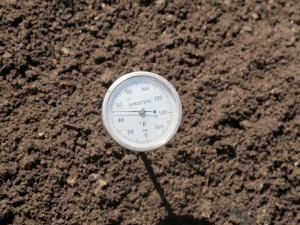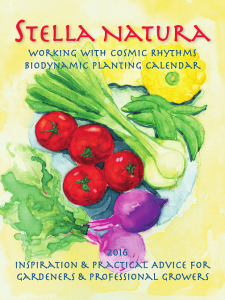Getting the Vegetable Garden Ready
I talked to a gardening friend who has already started planting a few things in his vegetable garden. Not me! Despite a few warm sunny days, it is way too cold and wet in my garden to do much of anything. Seeds will rot in cold, wet soil. Here’s what I’m doing – or not doing.
Technically, spring is here, but the soil temperature in my garden is in the thirties, even when the air gets into the fifties or warmer. We need consistently warm temperatures before I will plant outdoors because it takes time to warm up the soil. I want the soil to reach 50 degrees or warmer before I plant.
Yes, I take my soil’s temperature, much as I would a sick puppy or a child trying to avoid school. I have a thermometer that looks like an old analog oven thermometer: a steel probe with a round button with a dial on top that shows the temperature. Mine was designed for use in compost piles, so the probe is a couple of feet long. You can look at your local garden center, or order one from Gardeners Supply Company (www.gardeners.com) in Burlington, VT.
I’m not ready to rake off the leaves I spread on my vegetable beds last fall. In October I weeded my vegetable garden and then covered it with 4 to 6 inches of leaves that I’d run over with the lawnmower and raked up. The leaves kept the soil from washing from my mounded raised beds into the walkways (the beds don’t have planks to contain the soil).
Unfortunately, the layer of leaves is also an insulator, so the soil will stay colder than bare soil until I remove it. But the leaves inhibit weeds from growing, too. That’s a good thing. Since my soil is still pretty soggy, I don’t want to walk in the garden or disturb the soil.
Soil is actually a bit fragile at this time of year – step on it (or rototill it) and you can ruin its structure. So the leaves keep weeds from growing until I rake them off in late April or early May.
Once the leaves are off the beds and raked into the pathways, two kinds of weeds will grow: annual weeds and perennial weeds like dandelions and witch grass. Annual weeds grow from seeds and are easy to kill: you can run a sharp hoe just below the surface, slicing off the tops from the roots. That will kill annual weeds when they are small.
If you don’t get around to hoeing your beds and the weeds are well established, you could toast them! That’s right, cover a bed with clear plastic, seal the edges with soil, and in just a day or two of hot sunshine, they will be toast. I’ve measured the temperature in a bed being solarized, and on a 60-degree day, the temperature got over 100 degrees.
Perennial weeds need to be pulled. Their roots contain stored energy from last year, and generally even a scrap of root can regenerate and start a new plant. That is one of the reasons I don’t recommend rototilling. Chop up witch grass roots and each piece with a node will produce a new plant if it is within a few inches of the soil surface. It’s true that plowing a field and turning the sod under a foot of soil will kill most grasses, but that’s different than rototilling.
Meanwhile, indoors, it’s almost time to start planting. Generally I recommend starting most things 6 to 8 weeks before I put them outside. I plant tomatoes outdoors in early June. So April 10 is my planting date most years. I use a biodynamic calendar called Stella Natura (www.stellanatura.com) to advise me about planting dates. It uses the planets, stars and the moon to determine good times for planting fruits (tomatoes and peppers), roots (carrots and potatoes), flowers (artichokes and cauliflower) and leaves (lettuce and kale).
This year April 10th is a root day, but the two days before, according to Stella Natura, are fruit days up until 2pm on April 9th. At that point there is a blackout period until 6pm, and I will definitely not plant anything then. My informal experiments with blackout days have shown me that there is a significant disadvantage to planting then.
So what should you do if you didn’t weed and prepare your beds last fall? Start weeding, a little every day, as soon as your beds dry out. An easy way to see if your soil is ready to work is to grab a handful of soil and squeeze it. Hold that ball of soil, and tap it with a finger. If the soil is ready to work, it should crumble. If not, wait.
And when your soil is ready to work, think about creating some mounded, raised beds. You can do this by loosening the soil with a garden fork, then raking the loose soil into beds that are about 3 feet wide and stand up 4 to 6 inches above the walkways. Add a thick layer of compost on top, and scratch it into the soil at the top surface, and you’ll be ready to plant.
We all want to start gardening now, but do wait until your soil is as ready as you are!
Read Henry’s blog by going to https://dailyuv.com/




